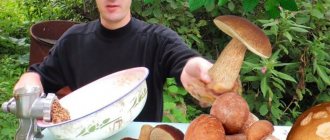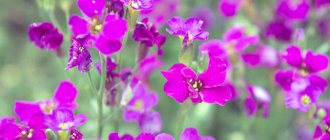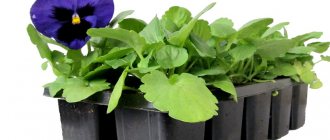Every housewife dreams of seeing her garden plot blooming and fragrant. For this, a lot of effort and time is spent, a combination of different plants is selected, and flower beds are erected. But it is impossible to imagine a single flower bed without a beautiful and delicate eustoma flower. In addition to growing in open ground, this plant looks great in a flower pot on the windowsill.
If the reader has never heard or seen this beautiful flower, then the editors of the Agronom.guru portal will help you understand the question of how to properly plant perennial eustoma and tell you about further care. The article will also present photos of buds and flowers that amaze with their beauty.
An ideal solution for decorating a personal plot
Types of Irish rose eustoma - brief botanical information
Perennial eustoma is a delicate and luxurious flower that came to our country from Central and South America and immediately won the hearts of many gardeners. In nature, only blue and purple flowers exist, but thanks to the efforts of breeders, varieties of various shapes and colors have been developed.
The flower is original not only for its beauty, but also for its various names. In each country, the plant has its own name: in Ireland - Irish rose, in Japan - Japanese, in France - French love rose, and in Ireland - Irish rose or Texas bluebell. Eustoma is also called lisianthus, which means “bitter flower” in Latin. The flower received its second name for a reason, since it belongs to the Gentian family and contains a large amount of gentianin, genceopecrin and genteamarin. All these poetic names are true and show the love of many countries for this amazing and unusual perennial.
Lisianthus and eustoma are the same plant
Indoor views
Today, flower growers actively grow about 5 species and varieties of perennial eustoma at home. A brief description of these varieties will be given below.
- Eustoma grandiflora. This is the most common variety, characterized by oblong or oval leaf blades, large bell-shaped flowers, and bright colors of white, red, blue or orange.
The species includes the following varieties: Wonderus Light Brown, Colorado Purple, Roccoco Marine White, Advantage Green.
- Eustoma "Mystery". It is characterized by a small height (up to 20 cm), as well as large double petals with a bright cobalt or blue color.
- "Little Bell" It also has a small height of up to 20 cm and is distinguished by a large number of green shoots. The inflorescences are small, funnel-shaped, most often light in color.
- Eustoma "Loyalty". It is distinguished by its small height and many small white buds.
- "Florida Pink". It is characterized by large pink buds that lighten and decrease in size over time.
Photo of a rose-like eustoma flower in a garden and bouquet
Irish rose can be grown at home on the windowsill and in the garden. This plant looks great as a cut flower because of its beautiful flowers, which resemble half-opened silky roses. Flowers can stand in water for a long time without losing their beauty.
Photo of flowers in the garden What eustoma looks like in bouquets, photo
Varieties of culture
Today, breeders have created a huge number of hybrids of various shapes and various colors. As a rule, manufacturers indicate the height of the plant on seed packets. When purchasing, you should also take into account the timing of flowering, since the period of bud formation varies greatly. Many of the resulting cultivars are combined into variety series.
For cutting, tall (about 1 meter) varieties are usually selected that look great in bouquets: “Echo”, “Aurora”, “Flamenco”, Heidi and many others.
Low-growing lisianthus will effectively replace fading plants in a flowerbed, for example, they will cover the exposed “legs” of lilies, and decorate the yellowing leaves of irises.
Compact bushes Mermaid (“The Little Mermaid” - in the photo), “Riddle”, “Loyalty” are also suitable for indoor growing
When choosing, they are guided primarily by the characteristics of the flowers, which can be simple, double or semi-double in shape, have the most varied colors of delicate silk petals: both single-color and variegated, two-color. The widest selection of F1 hybrids will help you create the desired color composition in your home interior and garden. The only thing that experts have not yet been able to achieve is to remove the climbing eustoma.
You can learn more about the botanical features of this herbaceous perennial and get acquainted with representatives of the most popular variety series in the article on our website.
Open ground or pot - where is it better to grow eustoma
Most gardeners wonder where it is better to grow perennial eustoma - in the garden or in the apartment? The answer is obvious that no matter where this flower grows, it will always delight its caring owner with its beautiful appearance. When grown in the garden, the plant will decorate any flower garden, will be an addition to rock gardens, and will also look beautiful in single plantings.
The most common is eustoma grandiflora.
Although eustoma is considered an annual plant when grown at home, it will, without any doubt, be one of your favorite indoor flowers, even though it must be grown from seeds every year. If you want to admire beautiful flowers on cold, short days, sow the seeds in mid-summer.
Eustoma prefers bright, diffused light
Russell's potted eustoma (Eustoma Russelianus)
This flower has a small compact bush, its height rarely exceeds 30 centimeters. Let's get acquainted with the most popular varieties of potted eustoma:
Mermaid variety. Lisianthus Little Bell.
The Mermaid variety has simple inflorescences up to 6 centimeters in diameter. The petals are pink-lilac or blue, the maximum height of the crop is 15 centimeters. The bush develops well and does not need pinching to form additional side shoots.
Lisianthus Light Bell is up to 15 centimeters tall with small simple inflorescences of different colors. The culture bushes well and does not require pinching of shoots.
Variety Fidelity. Florida Pink variety.
Variety Fidelity is a beautiful flower with many white inflorescences. A feature of the culture is the spiral arrangement of peduncles.
The Florida Pink variety is a fairly compact bush up to 20 centimeters in height. The inflorescences are pink with simple petals that form a beautiful bouquet.
Rozzi variety.
Variety Sapphire.
The Rozzi variety is one of the tallest crops of the species in question, its height reaches 30 centimeters. Double inflorescences with white, blue or pink petals.
Variety Sapphire with simple or double petals. The inflorescences have different colors, the height of the bush reaches 30 centimeters.
Variety Echo.
Variety Aurora.
How to plant eustoma seedlings
Growing eustoma from seeds will not be difficult even for a novice gardener. You just need to know when and how to plant seeds for seedlings. Since properly grown seedlings are the key to a strong and healthy plant.
When to plant eustoma when growing from seeds
Eustoma is a slow-growing plant that, when grown from seeds, will bloom only at 25 weeks. Therefore, in order to see the long-awaited flowering, the seeds are sown in mid-December or early January. Many gardeners carry out this procedure in early November.
Since the seeds have good germination, they do not need stratification
How to sow eustoma seeds for seedlings at home: step-by-step instructions
| Photo | Action |
| In order for the plant to delight with its flowering for many years, it is necessary to approach the choice of seeds with all responsibility. You need to buy them only from trusted manufacturers and in yeasted form. | |
| Before sowing, prepare nutritious, well-drained soil. For good ventilation of the seedlings, it is better to sow the seed in shallow furrows. We place the seeds in spilled soil, dig them a little deeper and install a microgreenhouse to create favorable conditions for rapid germination. | |
| If you follow the sowing rules, the first seedlings will appear in 2.5 months. All this time, the plant is growing a powerful root system, which has a positive effect on the growth of an adult plant. | |
| Picking is carried out at the stage of 2-3 true leaves into prepared nutrient soil. | |
| We water the seedlings well and put them in a warm, sunny place. We carry out the first feeding after 5-7 days with calcium nitrate, diluted strictly according to the instructions. Next, careful care of the young plant is necessary. |
Fertilizing Lisianthus
Growing eustoma in a greenhouse requires regular feeding. The composition of fertilizers depends on the acid-base reaction of the soil. The optimal soil reaction for a flower is 6, 6.2. And it must be maintained throughout the growing season.
Texas bluebell needs plenty of nitrogen and calcium. Potassium is also necessary for the flower; it is responsible for the development of a large flower, for its brightness and turgor.
Eustoma flowers must be fertilized with potassium for brightness and bud development
Each gardener applies fertilizers based on his experience. Let us give an example of the industrial cultivation of cut eustoma in the Temryuk region. There the farmer uses Raikat development, Aminokat, Kelik potassium, Kelik potassium with silicon, Razormin, Nutrivant Universal, Nutrivant Drip.
How to properly care for seedlings
In order for the plant to be strong and healthy, it is necessary to properly care for the seedlings. Maintain temperature and humidity conditions, carry out regular spraying and fertilize with complex mineral fertilizers every 10 days.
Properly grown seedlings are the key to long and beautiful flowering
Lighting, temperature and watering
After picking, seedlings require careful care:
- For good growth of eustoma, you need to create moderate warmth, daytime temperature - +20..+25°C, night temperature - not lower than +20°C.
- Eustoma is a light-loving plant. For rapid development, young seedlings need a lot of diffused light. Therefore, it is better to grow them on the western or eastern side. In winter, additional artificial lighting is installed.
- Watering is the most important stage in care. Since the plant does not tolerate both underwatering and overwatering. The soil in the pot should always be kept moist. The water should be soft, settled and not very cold. The flower will be grateful if it is watered with melt or rain water. Such water contains the necessary microelements for good growth and development. In winter, if the flower grows in an apartment, watering is reduced and the humidity is increased using a humidifier or a container of water.
- During the period of active growth, eustoma requires replenishment with mineral fertilizers in a slightly lower dosage than described in the instructions. With enough nutrients, growth will be faster, and flowering will be abundant and long-lasting.
Caring for a young plant will require a lot of effort and patience.
When and how to pick eustoma
Picking is carried out at the age of 6-8 weeks. To do this, prepare separate containers with nutritious, well-drained soil. The seedlings are carefully removed, trying not to damage the root system, and transplanted into separate containers with a diameter of 5 cm. During this period, the plant is regularly watered and fed once every 10 days.
The second picking is carried out after 30 days, when the plant gets stronger and grows green mass. You need to replant the plant to a permanent place, be it open ground or a flower pot, together with a lump of earth. The transplanted plant is watered and shaded from sunlight for 2-3 days.
You can learn how to properly dive eustoma from the video:
Picking is carried out at the age of 3 months
Other varieties of eustoma
"Aurora" begins to bloom earlier than other varieties of eustoma. Flowers grow up to 90–120 cm. The buds are large, double, and have several colors: blue, white, pink and light blue.
“Flamenco” is a variety series, the representatives of which reach an average height of 90–120 cm. Large inflorescences have a mix of colors depending on the variety, and also have a delicate aroma. The varieties are distinguished by their unpretentiousness and early flowering.
"White Kyoto" stands out for its large white flowers and pleasant aroma. The variety grows easily and quickly.
"Cinderella" is an annual plant with double buds. The bush has strong, branched stems reaching 50 cm. For growth, the variety prefers fertile soil and a well-lit area.
“Terry” has funnel-shaped lush flowers, 7–8 cm in diameter. They are pink, purple, lilac and white, and can also have two-color inflorescences. The stems grow up to 80–90 cm, begin to branch from the middle of the shoot, because of this the branches look like lush bouquets.
"Mariachi" is an annual flower that grows up to 80–100 cm. The stems are strong, with rather large lush inflorescences. In appearance, the eustoma bud is very similar to a rose. When cut, the flower does not lose its decorative appearance for a long time. Prefers areas with good lighting and moisture permeability of the soil.
"Mariachi Lime" has a beautiful yellowish-green coloring of the inflorescences.
'Twinkie' has beautiful purple buds with satiny petals arranged in a spiral. Branched shoots grow up to 50 cm. The plant is suitable for sunny areas with light fertile soil.
“White” stands out with very large white inflorescences. This eustoma is extremely often used when composing wedding bouquets and decorating halls.
- “Blue Haze” reaches a height of up to 1 m. The buds have wavy petals of a light lilac-blue tone. The inflorescences are distinguished by their splendor and terry structure.
- "Arena Red" combines the classics of a scarlet rose and the airiness of a field poppy. Bright red or cherry buds are terry, with a yellow-black center. They are located on erect, tall stems, up to 1 m. The flowering of the variety is quite long.
- Arena Pure White is distinguished by large snow-white inflorescences with double petals.
- Arena Blue Flash has two-color petals: rich and pale shades of lilac. The buds are very large - 7–8 cm in diameter. Grown mainly for cutting.
"Rosita white" is a tall bush, approximately 80–100 cm in height. The terry buds are medium in size and very similar in shape to a rose.
Heidi grows up to 90 cm. The variety is characterized by abundant flowering, the flowers have a simple shape. This variety is characterized by 15 color options.
- Fringe mint green stands out for its unusually beautiful petal colors. They are a soft mint green color.
- Beppin-San is distinguished by unusual petals that have heavily cut edges. They are shaped like feathers. The color of the buds is light pink.
- “Picolo Northern Lights” grows up to 80–100 cm, the stems are strong, but the bush looks very elegant. The inflorescences have a simple shape, petals of a delicate lime tone with a purple border around the edges. The plant prefers well-lit areas for planting.
- Corelli is distinguished by very large double flowers, the petals of which are figured, with graceful fringe along the edges. There are 6 color options. The height of the bush is 80–100 cm.
- Robella reaches a height of 80–100 cm. The buds are quite large. It has several varieties that differ in the color of the inflorescences: Blue Flash, Pure White, Clear Pink.
Tall
Tall varieties of eustoma look great in any flower garden and serve as an extremely elegant decoration for the site.
- "Alice" is distinguished by large double inflorescences that abundantly decorate the strong stems of the bush. The height of the plant is about 80 cm. Flowers are often grown as cut flowers, since they retain their fresh appearance for a long time and are easy to transport. The variety is characterized by a rich color palette, a pleasant aroma, and has several varieties: “Alice blue” with blue buds, “Alice white” with snow-white flowers, “Alice champagne” with a slight yellowish tint of petals, “Alice pink” with a pink color, “Eupricot” with a peach tone, “Green” with a greenish tint of inflorescences.
- “Echo” is one of the most popular variety series; flowers are often grown for cut flowers. The plant grows up to 70 cm in length, the flower petals are arranged in a spiral. The buds can be either single-colored or with a smooth transition of shades, and are distinguished by early flowering. The series has 11 varieties, which have different colors and flower sizes. The most popular: “Echo Yellow”, “Echo Champagne F1”.
- “Echo Pikoti pink F1” has a very beautiful decorative appearance. The erect stems (about 70 cm) are decorated with a large number of white buds with a soft pink border. The inflorescences have a terry structure. The petals are quite dense, silky, forming a funnel-shaped cup. Flowering is quite prolific and occurs in mid-summer.
- “Echo lavender” also has large double-type inflorescences with an elegant lavender color. It has a long flowering period.
- “Super Magic” is a variety series of eustoma with large double flowers. The height of the bush is 70–90 cm. Among the popular ones: Apricot, Capri Blue Picotee, Champagne, Deep Blue, Green, Light Green, Lilac, Pure white, Rose, Yellow.
- "Magic Capri Blue Picoti F1" belongs to the tall varieties bred by Japanese breeders. Snow-white petals are decorated with a bright purple border. The buds are very double, multi-layered, reaching 7 cm in diameter. The stems of the bush are strong, growing up to 70 cm. The variety has a highly decorative appearance and is often used for planting in flower beds, ridges and as a decoration for borders.
- “Magic Green Alley F1” is distinguished by long-term flowering, super-double inflorescences reach 6–8 cm in diameter, their color is white with a slight green tint, unopened buds have a greener tone. The bush grows up to 70–80 cm, grows well in partial shade. The variety is ideal for cutting as it retains its fresh appearance for a long time.
- "Bolero" is distinguished by large, lush inflorescences. It has several varieties: Bolero Blue Picotee, Bolero White, Bolero Blue Blush.
- "Excalibur Blue Picoti" grows above 70 cm. The buds are lush and quite large in size. During flowering, the bush is densely decorated with white inflorescences with an elegant blue-violet border.
- "Excalibur hot lips" is distinguished by large snow-white flowers with a beautiful red border along the edges of the petals.
- Croma has super-double petals, which gives the inflorescences additional volume. The buds are medium-sized, formed on well-branched shoots. The height of the bush is 80–100 cm. The color and growth depend on the variety, and the variety series has several of them. Single-color: Green 1 and 2, Lavander 4, Lavander Improve 4, Silky White#, White 3, Yellow 3, two-color: Blue Picotee 3, Pink Picotee 3.
- ABC F1 is a large-flowered variety with double petals. The color of the buds (5–6 cm) is varied: pink, purple, blue, white. It blooms profusely and for a long time, the stems grow up to 100–110 cm. Loves sunny areas and regular watering. Varieties are grown for cutting; the flowers retain their fresh appearance for a long time and are easy to transport.
- "ABC 1 Green" stands out for its unusual large terry buds of a light green tone. The stems are durable and can easily withstand even strong gusts of wind. The bush reaches a height of 80–100 cm.
- "ABC 2 F1 Pink Mist" has large double buds of a soft pink tone. Flowering is mid-early, the inflorescences are 5–6 cm in diameter. The height of the bush is approximately 90–110 cm.
- Aube has very beautiful lush buds with thick petals. Strong stems reach 80 cm in height. The series consists of several varieties, which can be either plain (Cocktail Champagne, Pink Picotee) or with contrasting edging (Blue Picotee).
- "Laguna Deep Rose" is distinguished by double pink inflorescences.
- "Major Deep Rose" grows up to 80–100 cm. The buds are double, light pink.
short
Low varieties of eustoma are ideal for cultivation as a houseplant.
- Little Bell grows up to 15 cm. The bush has simple funnel-shaped buds, their colors can be different.
- “Sapphire White” is also a dwarf variety; the bush grows up to 15 cm in height. The plant has a compact size with well-branched stems. The buds are medium, snow-white in color.
- “Sapphire Pink Haze” is a squat bush (10–15 cm) with leaf blades covered with a bluish coating. Large buds are funnel-shaped, the color of the petals is white, with a wide pink border. Sunny places are more suitable for growth.
- "Florida F1 Silver" grows up to 20–25 cm. It is distinguished by lush and long-lasting flowering. The buds have satiny white petals with a dark center. Mostly planted as a potted crop.
Florida Pink is a variety with fairly branched shoots, on which large double buds of pink or beige-pink are formed. The plant is a perennial.
“Fidelity” is a low flower (up to 20 cm) with simple white buds. The flowers are numerous but small.
- Mermeid, or "Little Mermaid" , grows up to a maximum of 15 cm. The bushes are quite branched and lush. The variety has several varieties that differ in the color of the buds: white, blue, pink.
- “Riddle” reaches only 20 cm in height and has compact parameters. Eustoma buds are very similar to a light blue rose with delicate, satiny petals. The plant is very sun-loving.
“Carmen” is distinguished by a rather long flowering period, during which the bush is covered with medium-sized inflorescences, the color depends on the variety. The flower has very high resistance to diseases. The height of the bush is 20–25 cm; for growth, semi-shaded areas protected from drafts are preferable.
“Carmen blue F1” with dark blue buds with a diameter of 4–6 cm. The bush itself grows on average up to 20 cm. The variety is classified as an annual.
Ivory Carmen belongs to the squat varieties and grows to only 15–25 cm. It is often planted as a houseplant. The inflorescence is simple, white in color with a faint cream tint.
“Carmen white-blue” - medium-sized white buds decorated with a blue border.
"Carmen Lila" stands out for the delicate lilac color of its petals.
“Matador” - the variety series is distinguished by large double inflorescences of pink, blue or white color, depending on the variety. The height of the bush is 10–15 cm, the leaf blades have a light bluish coating. The plant needs sunlight and abundant watering, as well as spraying.
Planting seedlings in open ground
The young plant is planted in mid-May, when the threat of spring frosts has passed.
If the flower has produced 6-8 leaves, it means it is ready for replanting.
Before planting seedlings in open ground, you need to find a place and prepare the soil. A place for planting is suitable with light partial shade, since a flower in the open sun can get burns on the leaves. Also, do not plant in a place where water accumulates. This leads to rotting of the root system and death of the plant.
For good growth and long flowering, eustoma is planted in well-drained sandy loam or loamy soil with neutral acidity. For planting, dig a hole, lay drainage and mineral fertilizer. The young plant is removed from the pot by transshipment and placed in a prepared place. When planting, do not deepen or expose the root collar. The planted plant is thoroughly watered, and the ground is mulched with straw or freshly cut grass to retain moisture.
The distance between the holes must be at least 40 cm from each other.
Soil suitable for planting eustoma
Experts say that lisianthus is quite demanding in agricultural technology, in temperature, water and ventilation conditions, as well as in mineral nutrition.
Attention! The secret to successfully growing a delicate flower is in the air. It should be fresh, warm and moist.
The soil for seedlings must also be special; there are several options:
- garden soil, coarse sand and humus in a ratio of 1:1:1. You can add a little lime.
- peat with a small amount of sand or perlite;
- light peaty soil with the addition of pieces of charcoal or tree bark humus;
- ready-made soils for violets or saintpaulias.
The soil should be moderately moist, not dry or waterlogged.
Caring for eustoma in the garden
Caring for the flower is simple. The main thing is to water and feed the plant on time. During active growth, the soil around the plant is regularly loosened and kept moist. To do this, the ground is mulched with straw, leaves or bark.
During flowering, mineral complex fertilizers with a high potassium content are applied. Tall varieties are provided with a support that will protect them from gusty winds and from the pressure created by a large number of buds and flowers. For long-term flowering, it is necessary to promptly remove dried inflorescences so that the plant does not waste energy on ripening the seeds.
What could be more beautiful than eustoma growing in the garden?
Preparing for winter
When the Irish rose fades, it is necessary to prepare for wintering. In regions with warm winters, the flower can overwinter in open ground. If winters are harsh and snowy, then the plant is dug up, transplanted into a pot and taken to a room where the air temperature does not drop below +15°C. If the temperature is too high, the leaves of the lisianthus will turn yellow, and over time the plant will dry out completely.
Low temperatures also have a detrimental effect on the flower. In winter, most plants enter a dormant period, during which time they accumulate strength for future growth and flowering. During the hibernation period, the plant requires proper care. Watering is kept to a minimum, making sure that the soil is kept moist. In spring, the awakening of the plant can be recognized by the appearance of new young leaves. As soon as the temperature stabilizes, the bush is planted in its original place and awaits the long-awaited flowering.
At the slightest frost, lisianthus dies
Growing eustoma from seeds
Growing lisianthus indoors will require quite a lot of time and patience. But if you master this process, you can turn growing eustoma from seeds into a profitable business, since every year it is gaining more and more popularity among both flower growers and gardeners.
Difficulties can begin already during sowing, since the seeds of this plant are very small (there are up to 23 thousand of them in 1 g). Seeds sold in specialized stores undergo special treatment, which increases their germination rate. In this regard, out of 100 such seeds, about 60 sprout. If seedlings are grown for planting in open ground, then the seeds are sown in February–March, then in this case the bushes will bloom in July–August. The soil mixture for sowing is used the same as for other flowering plants, namely: disinfected, with a pH of 6–7 and a low nitrogen content. Fill the container with wet substrate and distribute the seeds evenly on its surface; you do not need to sprinkle them with a layer of soil, but simply press lightly with your hand. Cover the top of the container with glass (film), leaving gaps so that air can circulate. Also, crops will need additional illumination with fluorescent lamps for 10–12 hours a day. In order for the seeds to germinate, they are provided with a temperature of no lower than 14 degrees at night and no lower than 20 degrees during the day. Water the crops with a spray bottle, but only if necessary. At first, you don’t need to water, because the evaporated moisture will be enough for the seeds.
If you do everything correctly, then the first seedlings will appear in about 15 days, immediately after this the glass is removed completely, and the seedlings are systematically moistened with a sprayer with a solution of Fitosporin. After the seedlings have formed several pairs of leaf blades (after approximately 6 weeks), they are picked into separate pots, reaching 40 to 50 mm in diameter. After 3 months, the bushes are transplanted into the garden, and they are taken along with a lump of earth.
Eustoma from “A” to “Z” - a complete guide to growing!
Caring for eustoma at home when planting in a pot: step-by-step instructions with photos
| Photo | Action |
| In order for the Irish rose to decorate your apartment, you can sow the seeds yourself or purchase an already mature seedling. | |
| For a plant to grow and develop well, it needs bright, diffused light. On the south side it is shaded from direct sunlight. In summer, the flower is taken out into the open air, be it a loggia or a personal plot. In the autumn-winter period, additional lighting is necessary. | |
| The air temperature in summer should not fall below +20°C. With the onset of autumn, the temperature decreases. If the flower is grown as a perennial, it is necessary to provide it with a dormant period in winter. The temperature at this time should not rise above +15°C and not fall below +10°C. | |
| Humidity also plays an important role. When the air is dry, the plant will shed its leaves. A humidifier is installed to increase the air. Spraying is strictly prohibited, as too high humidity leads to fungal diseases. | |
| Water once every 7 days as the soil dries out. The water that forms in the pan is removed immediately, as this can lead to rotting of the root system. | |
| During the period of active growth and flowering, the Irish rose is fed with mineral fertilizers every 10 days. | |
| If eustoma is grown as an annual, it does not need to be replanted. If it is a perennial, transplantation is carried out using the transshipment method. | |
| For long-term flowering, faded stems are removed, leaving at least two pairs of leaves. New shoots will grow from these stems over time. | |
| To prevent the development of fungal diseases, the plant should not be allowed to overcool. If you follow these simple rules of care, eustoma will become your favorite indoor plant, which will delight its owner with abundant and beautiful flowering. |
Reproduction methods
To propagate eustoma, gardeners most often use seeds, less often cuttings. Seed method of propagation of these beautifully flowering plants
To obtain lisianthus seedlings from seeds, it is recommended to sow the seeds in February or March. The seeds are sown in containers with a very loose soil mixture consisting of peat soil and fragments of the bark of deciduous trees (1:1). A ready-made store-bought substrate intended for growing seedlings is also suitable for sowing seeds.
Before sowing, the surface of the substrate is leveled and well moistened. Then the seeds are laid on the moistened soil (it is recommended to purchase seed material in pelleted form) at a distance of 2-3 centimeters from each other. The spread seeds are lightly pressed to the ground with a fingertip, after which the crops are sprayed with warm water from a spray bottle. You cannot sprinkle the seeds with sand or soil.
Next, the container with the crops is covered with a transparent film, in which several small holes are made for better air circulation. Before the emergence of seedlings, they carefully monitor the level of humidity of the soil and air in the improvised “greenhouse”. The waiting period for the first shoots is 2-3 weeks. Before the emergence of seedlings, the container with crops must be periodically ventilated, occasionally spraying the substrate.
In the second half of March, the container with seedlings should be sent to a place with soft diffused light, protected from drafts. The air temperature in the room should be +20-22°C. Strong seedlings can be planted after 6-8 weeks, when they have formed 2-3 pairs of true leaves. Postponing picking to a later date is strongly discouraged.
Some tall varieties of lisianthus can be propagated by apical or intermediate cuttings. This procedure is usually carried out during the period when plants are in the phase of active growth and budding. To obtain planting material, the strongest multi-stemmed eustoma bush is selected, from which a healthy, well-developed shoot is separated. This shoot is cut into pieces so that each cutting has about 4-5 internodes.
Next, the lower leaves on the resulting cuttings are removed, and the upper ones are cut in half. Then the lower cut of each cutting is powdered with a root formation stimulator (“Kornevin”) and placed in a glass of water for 6-8 hours. Root lisianthus cuttings in plain water. If all recommendations are followed, the first roots of the cuttings appear after 2-3 weeks. After this, the rooted planting material can be planted in separate cups with loose soil.
Diseases and pests of eustoma
With good care, eustoma is very rarely exposed to disease and attack by insect pests. But there are times when the following appear on your favorite flower:
- spider mite;
- aphid;
- scutum;
- slugs
Treating the flower with Aktara or Fitoverm will help you quickly get rid of pests. When slugs appear, it will be more effective to collect them manually to prevent them from crawling onto neighboring plants.
The most common diseases are:
- powdery mildew;
- gray and root rot;
- Fusarium
Before treating with insecticides, the bush is carefully inspected and all damaged areas are removed.
You can also fight pests and diseases using traditional methods. To do this, mix red and black pepper, powdered mustard and garlic gruel. Everything is filled with water and left to infuse for several days. The resulting solution is used to treat the plant in cloudy weather, since burning substances can cause leaf burns.
With proper care, eustoma will never know about pests or diseases
Why is eustoma compared to a rose?
Eustoma (lisianthus) is an ornamental plant that, thanks to its beautiful flowers, resembles a rose in many ways. Flowers are up to 8 cm in diameter. Eustoma has a straight trunk with branches, matte bluish leaves and no thorns. The height of tall varieties can reach 1.2 m.
Landscape designers use the plant to decorate the garden, and florists actively introduce it into spectacular bouquets. This is facilitated by the fact that even cut plants can retain freshness in a bouquet for a long time.
Popular varieties of perennial eustoma, grown in the middle zone, include the following varieties:
- Russella - large-flowered variety;
- Echo – grown primarily for bouquets;
- Aurora, which blooms early and has double, showy flowers;
- Mermaid - a potted version of eustoma, has a height of about 15 cm;
- Flamenco is an unpretentious tall flower;
- Little Bell variety.
Lisianthus has many varieties that differ in size and color.
Sources
- https://stroy-podskazka.ru/eustoma/opisanie/
- https://stroy-podskazka.ru/eustoma/vyrashchivanie-v-domashnih-usloviyah/
- https://pocvetam.ru/komnatnye-rasteniya/eustoma-vyrasivanie-iz-seman-v-domasnih-usloviah.html
- https://glav-dacha.ru/yeustoma-komnatnaya-vyrashhivanie-i-ukhod/
- https://glav-dacha.ru/yeustoma-mnogoletnyaya-posadka-i-ukhod/
- https://nashgazon.com/tsvety/klumby/eustoma-mnogoletnyaya-posadka-i-uhod-foto.html
- https://stroy-podskazka.ru/eustoma/mnogoletnyaya/
[collapse]
Brown and burgundy
In addition to popular colors of inflorescences, such as white, pink or purple, there are varieties of eustoma with a rather amazing palette of colors. We have selected several unusual varieties for you.
"Deep Brown" in the episode "Rosanne 2". A tall variety with a standard double flower, but of rare color. The color is translated as "dark brown", but it is described as lavender brown.
"Brown" in the series "Rosanne1". This variety is from the same series, only with the first group of flowering. It is difficult to describe the color palette of the inflorescence in one word. You can say lemon color, turning into a light brown shade with lilac notes or close to burgundy color.
Introduction
There are several leading companies in the world engaged in eustoma breeding. In the Russian Federation, mostly seeds from these producers are sold, but packaged by local companies.
Because of this, confusion often arises in the names of varieties. Therefore, we will present international names presented on the official websites of breeders. In most cases, varieties are named after a color, and this color is included in several collections.
Eustoma varieties are divided into five groups depending on the timing of flowering.
Group “0” – very early, “1” – early, “2” – middle, “3” – late, “4” – very late. Some manufacturers distinguish four groups, without the “super early” one.
Lisianthus varieties are most often bred from the species Eustoma Russellianus (Russell), formerly called Grandiflorum or Eustoma large-flowered.











